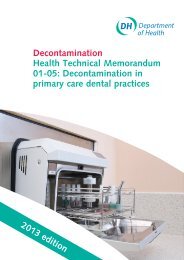A study of Patent Thickets (1.31Mb) - UK Intellectual Property Office
A study of Patent Thickets (1.31Mb) - UK Intellectual Property Office
A study of Patent Thickets (1.31Mb) - UK Intellectual Property Office
You also want an ePaper? Increase the reach of your titles
YUMPU automatically turns print PDFs into web optimized ePapers that Google loves.
A Study <strong>of</strong> <strong>Patent</strong> <strong>Thickets</strong> 35<br />
2.2 Small and medium-sized enterprises<br />
Policy makers widely believe that small and medium sized (SMEs) businesses create most <strong>of</strong> the<br />
new jobs in modern economies. Therefore, it is <strong>of</strong>ten thought that support for SMEs is an<br />
important element <strong>of</strong> policy that is directed towards creation <strong>of</strong> more employment and growth.<br />
It is also true, that previous work for the <strong>UK</strong> has shown that growth comes from a small share<br />
<strong>of</strong> SMEs (Anyadike-Danes et al., 2010). These researchers find that between 2005 and 2008,<br />
only around 6 per cent <strong>of</strong> registered companies accounted for more than half <strong>of</strong> total employment<br />
growth.<br />
In this section we briefly review work on the survival and growth <strong>of</strong> SMEs in the literature, with a<br />
particular focus on the <strong>UK</strong>. We focus in particular on the link with firms’ patenting activity. This<br />
will help us gauge the implications <strong>of</strong> our findings on how firms’ patenting activity is affected by<br />
thickets for their performance in the market place.<br />
The most recent <strong>study</strong> on SMEs and job creation in the United States is by Haltiwanger et al.<br />
(Haltiwanger et al., 2010). This paper focuses mainly on the question whether SMEs create<br />
most private sector jobs. The paper provides new evidence as well as a review <strong>of</strong> methodological<br />
and statistical problems that plague the literature on SMEs and job creation. One main finding<br />
is that 40% <strong>of</strong> jobs created by young start-up firms are eliminated by the exit <strong>of</strong> these firms after<br />
five years. However, those young firms that survive are found to grow much faster than previously<br />
existing firms. Haltiwanger et al. (2010) seek to replicate results <strong>of</strong> Neumark et al. 2011 (Neumark<br />
et al., 2011) who find that small firms contribute disproportionately to net job growth in the U.S.<br />
economy. Haltiwanger et al. (2010) show that controlling for age removes any correlation<br />
between firm size and net job creation. The reason for this is that young firms and especially<br />
start-up firms are generally also small firms. In the United States young and small firms<br />
disproportionately create and destroy jobs. This means that it is not so much the size <strong>of</strong> the firm<br />
that matters for job creation rather than the age <strong>of</strong> the firm.<br />
Balasubramanian and Sivadasan (2011) use matched census data for the US manufacturing<br />
sector to show a strong, positive correlation between first-time patenting and subsequent<br />
growth. They suggest that first-time patentees experience exceptionally high growth as a<br />
consequence <strong>of</strong> introducing new products. While it remains unclear to which degree the<br />
patenting decision itself causes the increase in the number products, this evidence is relevant<br />
to our <strong>study</strong>. We look at entry in form <strong>of</strong> first-time patenting, which means that evidence provided<br />
by Balasubramanian and Sivadasan (2011) could suggest that a negative correlation between<br />
first-time patenting and thickets is indicative <strong>of</strong> a negative association between thickets and<br />
growth. Helmers and Rogers (2011) <strong>of</strong>fer some evidence on the link between patenting and<br />
growth for the <strong>UK</strong>. They look at start-up companies’ patenting decision shortly after they enter<br />
the market. They also find a strong positive correlation between start-up firms’ patenting<br />
decision and their subsequent growth performance.<br />
Regarding firm survival, there are two relevant studies in the United Kingdom: Disney et al.<br />
(2003) and Helmers and Rogers(2010). Disney et al. use the Annual Business Inquiry<br />
Respondents Database (ARD), which starts in 1972. The data contains information on all <strong>UK</strong><br />
manufacturing establishments over 100 employees and a sample <strong>of</strong> smaller establishments.

















